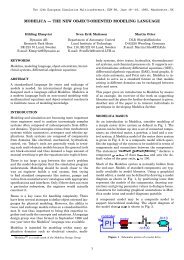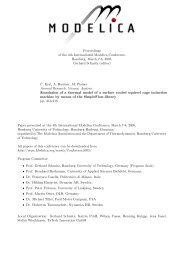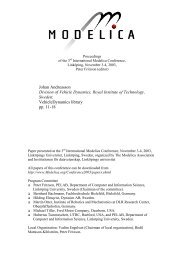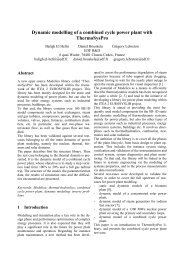Hilding Elmqvist, Hubertus Tummescheit and Martin Otter ... - Modelica
Hilding Elmqvist, Hubertus Tummescheit and Martin Otter ... - Modelica
Hilding Elmqvist, Hubertus Tummescheit and Martin Otter ... - Modelica
You also want an ePaper? Increase the reach of your titles
YUMPU automatically turns print PDFs into web optimized ePapers that Google loves.
H. <strong>Elmqvist</strong>, H. <strong>Tummescheit</strong>, M. <strong>Otter</strong> Object-Oriented Modeling of Thermo-Fluid Systems<br />
additional properties are needed, e.g. the parameters<br />
to compute chemical equilibrium reaction constants.<br />
<strong>Modelica</strong>_Media will initially not contain models<br />
for reactive flows, but all data is present for users<br />
who wish to define such models.<br />
7 Conclusions<br />
Thermodynamic fluid modeling is complex in many<br />
ways. This paper has shown a careful structuring of<br />
libraries for medium <strong>and</strong> fluid components in such a<br />
way that the same component models can be used<br />
with different easily replaceable media. To our<br />
knowledge this is the first approach that is able to<br />
treat compressible <strong>and</strong> incompressible fluids in a<br />
unified framework. A careful consideration of<br />
numerous issues concerning numerical efficiency,<br />
model structuring <strong>and</strong> user friendliness has been<br />
presented in this paper:<br />
• Suitable device interfaces<br />
• Principles for h<strong>and</strong>ling of reversing, joining<br />
<strong>and</strong> splitting flows<br />
• The governing partial differential equations<br />
<strong>and</strong> their transformation into ODEs<br />
• Pressure loss calculations<br />
• Medium interface design<br />
• Initialization<br />
• Media available in <strong>Modelica</strong>_Media<br />
Much design effort has been spent on considerations<br />
for robust <strong>and</strong> efficient simulation. The presented<br />
framework <strong>and</strong> libraries have the potential to serve<br />
as a powerful base for the development of<br />
application-oriented libraries.<br />
Appendix – Energy balance<br />
This appendix contains the derivation of the<br />
equivalent but simpler energy balance.<br />
Multiplication of the momentum balance by v<br />
gives<br />
2<br />
⎛∂( ρvA) ∂(<br />
ρvA)<br />
⎞<br />
v ⎜ + ⎟ =<br />
⎝ ∂t ∂x<br />
⎠<br />
∂p ∂z<br />
−vA −vF −vAρ<br />
g<br />
F<br />
∂x∂x Utilizing the mass balance, this equation can be<br />
rewritten as<br />
2 3<br />
∂( ρ( v /2) A) ∂(<br />
ρ(<br />
v /2) A)<br />
+ =<br />
∂t ∂x<br />
∂p ∂z<br />
−vA −vF −vAρ<br />
g<br />
F<br />
∂x ∂x<br />
To show the equivalence, consider the two left h<strong>and</strong><br />
sides:<br />
2<br />
∂( ρvA) ∂(<br />
ρvA)<br />
LH = v + v =<br />
1<br />
∂t ∂x<br />
⎛∂v ∂( ρA) ∂v ∂(<br />
ρvA)<br />
⎞<br />
v⎜ ρA+ v + ρvA+<br />
v ⎟ =<br />
⎝ ∂t ∂t ∂x ∂x<br />
⎠<br />
⎛∂v ∂v ⎛ ∂( ρA) ∂(<br />
ρvA)<br />
⎞⎞<br />
v⎜ ρA+ ρvA+<br />
v⎜<br />
+ ⎟⎟ =<br />
⎝ ∂t ∂x ⎝ ∂t ∂x<br />
⎠⎠<br />
⎛∂v ∂v<br />
⎞<br />
v⎜ ρA+ ρvA⎟<br />
⎝ ∂t ∂x<br />
⎠<br />
LH<br />
2<br />
2 3<br />
∂( ρ( v /2) A) ∂(<br />
ρ(<br />
v /2) A)<br />
= + =<br />
∂t ∂x<br />
2<br />
∂( v /2) 2 ∂(<br />
ρ A)<br />
ρ A+ ( v /2) +<br />
∂t ∂t<br />
2<br />
∂( v /2) 2 ∂(<br />
ρvA)<br />
ρvA<br />
+ ( v /2) =<br />
∂x ∂x<br />
∂v 2 ∂(<br />
ρ A)<br />
v ρ A+ ( v /2) +<br />
∂t ∂t<br />
∂v 2 ∂(<br />
ρvA)<br />
v ρvA+<br />
( v /2) =<br />
∂x ∂x<br />
⎛ ⎞<br />
⎜ ⎟<br />
⎝ ⎠<br />
∂v ∂v<br />
v ρA+ ρvA<br />
∂t ∂x<br />
i.e. LH = LH .<br />
1 2<br />
Subtracting the equation derived above from<br />
the energy balance gives<br />
p<br />
∂ ( ρvu<br />
( + ) A)<br />
∂( ρuA) ρ ∂p∂ ∂T<br />
+ = vA + ( kA )<br />
∂t ∂x ∂x ∂x ∂x<br />
Acknowledgements<br />
The design of this library has been a collaborative<br />
effort <strong>and</strong> many have contributed. Many thanks to<br />
Mike Tiller for suggesting the package concept <strong>and</strong><br />
useful discussions <strong>and</strong> proofreading the paper.<br />
Many thanks to Rüdiger Franke for the first realistic<br />
tests of the libraries <strong>and</strong> his feedback, many thanks<br />
to Daniel Bouskela, Andreas Idebrant, Gerhart<br />
Schmitz, John Batteh, Charles Newman, Jonas<br />
Eborn, Sven Erik Mattsson, Hans Olsson <strong>and</strong> the<br />
users of the ThermoFluid library for many useful<br />
comments <strong>and</strong> feedback.<br />
The <strong>Modelica</strong> Association <strong>Modelica</strong> 2003, November 3-4, 2003

















